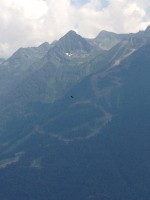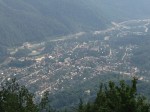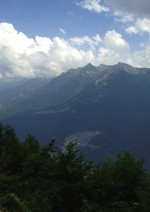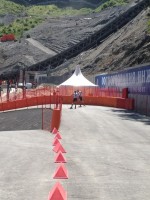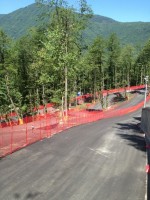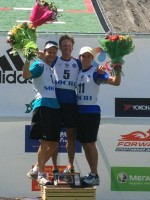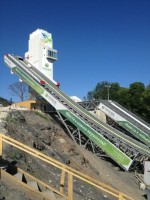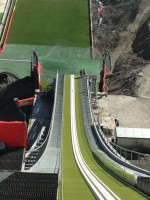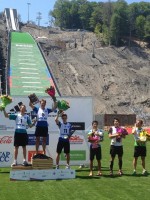
At the biggest international competition of the summer, hardly anyone could blame the Americans if their heads weren’t totally in it.
It’s not that they weren’t focusing on nordic combined’s International Ski Federation (FIS) Summer Grand Prix. They just had a lot of other things to absorb during their first visit to Sochi, Russia.
For veteran competitors like Todd Lodwick, Johnny Spillane and Billy Demong, the new venue was a welcome change to their routine trips to the sport’s typical sites. Sure, they loved their jumps in Park City, Utah, and enjoyed getting some practice in Oberstdorf, Germany, before heading to Russia about a week ago. But sometimes, unique sights are the most stimulating.

The U.S. Nordic Combined team soaked up plenty last weekend at the under-construction venue near Krasnaya Polyana, about 40 kilometers northeast of Sochi. For the 2014 Olympics, the “Mountain Cluster” will host all the of the ski, snowboard and sled events (bobsled, luge and skeleton) and high-speed gondolas and trains will be in place to get people where they need to be.
Eighteen months before the Winter Games, U.S. head coach Dave Jarrett estimated there were 60,000 laborers running around, working around the clock in six-week shifts to get the job done. The Americans were only there for an extended weekend at the Summer Grand Prix (SGP) July 21-22, yet managed to capture the energy.
“I think everyone was psyched, especially the older guys,” Jarrett said on the phone from Florida, where he met his family for vacation after returning from Sochi. “It’s not every year that they get to go to a new jump or a new place. It [can be] like Groundhog Day all over again. Those guys were psyched to be somewhere new.”
The oldest member of the A-team, Lodwick, 35, did exceptionally well in the hot and humid conditions, with temperatures around 95 degrees Fahrenheit that rose higher on the newly paved rollerski track. After placing second on Saturday, Lodwick won gold at the Grand Prix on Sunday and raced the fastest time on both days.
While Lodwick couldn’t be reached for comment, Jarrett talked about his performance – more impressive considering Lodwick hadn’t competed since December of last season. The 2009 World Champion last won a race nearly two years ago at a Continental Cup in his hometown of Steamboat Springs, Colo. A five-time Olympian, Lodwick hadn’t been on the podium since the 2010 Vancouver Games, where he won silver in the team event, yet had six World Cup victories and 26 podiums to his name.
“He’s definitely a competitor,” Jarrett said. “He’s been around for a long time. I wouldn’t bet against him, but I wouldn’t have picked him to do as well as he did … on the jumping hill. I think he was really psyched and I think it gives him some motivation moving forward.”

Jarrett knew Lodwick could dominate a relatively thin Grand Prix field in the 8.8 k rollerski race, but was surprised by how well he jumped on the 140-meter large hill. On Saturday, Lodwick ranked ninth in the jump and climbed seven places in the Gundersen-start race to finish second, and Sunday, he finished fifth in the jump and landed the top spot overall.
“He’s been obviously doing a good job,” Jarrett said, adding that Lodwick hadn’t jumped as well in practice leading up to the event.
Four months ago, Jarrett wasn’t sure what Lodwick’s plans were. He essentially took last year off to remedy some pulmonary issues, and with a wife and two young children at home, Jarrett couldn’t blame him. However, with the 2014 Olympics fewer than two years away, Jarrett had a more frank discussion with Lodwick this spring.
“He and I sat down in March, and basically, I required him to make a commitment,” Jarrett said. “If he wasn’t going to commit to being a full-time athlete and good teammate, then there wasn’t going to be a place for him because he technically didn’t qualify for the team based on his results last year.”
With his sixth Olympics in sight, Lodwick chose to commit. According to his biography on the U.S. Ski and Snowboard Association (USSA) website, Lodwick said last season was a difficult because his asthma prevented him from training.
“I got down on myself and wondered if this was something I wanted to continue to do,” Lodwick said. “But this sport provides so much more to me than winning. I’m truly passionate about it. And with the staff we have and the athletes on the nordic combined team, I couldn’t ask for a better bunch of guys to work with to push the sport to the next level.”
Lodwick wasn’t the only American who shined in Sochi; Spillane and Taylor Fletcher also made the top 10 on Sunday.
Spillane, who finished seventh overall, said he was pleased with how things went at the SGP, but didn’t put too much thought into summer results.
“It really doesn’t matter at all, but the trip served its purpose for us to go there and get a feel for what it’s like over there,” Spillane said on the phone from Steamboat Springs. “As far as the competitions go, I was happy with how it went, and my goals aren’t to do well in July by any means.”
On the phone in Park City, Fletcher confirmed that his 10th place was a Grand Prix career best, but that didn’t mean a whole lot to him, either.
“It wasn’t a full field, which is kind of a bummer, but it’s good to go,” he said of the competition, which included several top jumpers from Austria and Japan, but lacked some of the best athletes from Norway and Germany. “Nonetheless it was still a good show and everybody had a good time.”
The Big Picture
Aside from testing Sochi’s new venue, the U.S. team also wanted to get its bearings before traveling to Russia again this winter. From Feb. 2-3, they’ll compete on the same large hill near Krasnaya Polyana and race a similar course.
About Taylor Fletcher and Billy Demong’s Grand Prix DQ’s:
According to Jarrett, the Grand Prix presented a good opportunity to compete at a new World Cup and Olympic venue, but he didn’t take it too seriously.
“On the jumping hill, it was clear that we certainly made improvements, which was what we were looking for,” Jarrett said.
“To have those guys ski as well as they did was a bonus, but if they were horribly slow it wasn’t going to be the end of the world either. It turned out well.”
Demong finished seventh on Saturday and was disqualified Sunday because his suit was three centimeters too loose. On Saturday, Taylor Fletcher was disqualified after the jumps because his undersuit had holes in it.
Jarrett didn’t have a problem with the Demong’s disqualification – Demong opted not to tighten his suit the night before – but he did take issue with Fletcher’s DQ.
“Taylor got disqualified because he broke an undersuit rule, an underwear rule,” Jarrett said with a laugh. “They didn’t enforce it last year. … They pick certain people to get checked every day, but the threat of being checked is there all the time.”
Regardless, Jarrett couldn’t believe he was spending so much time discussing threads, needles and bobbins.
“Now your suits basically become illegal because it becomes too big after a few jumps,” he said.
“Tongue and cheek, I joked that we ought to hire a seamstress instead of a second service guy [to travel with us]. It’s pretty stupid when a sport comes down to that. … We brought our sewing machine from Europe and those guys were sewing their suits before the competition.”
“The Grand Prix is just that; there wasn’t a lot of teams that came to Sochi,” Jarrett said. “It’s more important to just be there and jump on the jumps more so than the competition.”
In the winter, racers will have to do the full 10 kilometers on a slightly longer loop (the rollerski course was shortened to keep within maximum climbing limitations), and they’ll start and finish in the jumping flats so that spectators can watch from their stadium seats.
Another difference is that skiers probably won’t sink into the pavement like they did last weekend.
“It was so hot out that our rollerski [pole] tips were sticking; we were digging into the pavement and our wheels were running on hot, hot tar,” Fletcher said. “It’s a hard course and it’s going to [be] really challenging in the winter because everything’s going to be a little bit longer and … you’re not going to have the same speed that you have on rollerskis, I don’t think.”
Fletcher’s older brother, Bryan, tried to look beyond his results last weekend (16th on Saturday, 21st on Sunday) and envision himself competing there this winter.
“I held some hopes for the jump hill however after an extremely tough week in France for our TDF [Tour de France] camp, I knew I would be tired heading into the competitions,” Bryan wrote in an email, referring to the team’s preceding cycling camp in the French Alps. “I am not strong in extreme heat and humidity and Sochi had plenty of both.”
Outside of competition, he noted the magnitude of the development going on near Sochi, referring to the amount of construction as “astronomical.” All the snow venues will be accessed by gondolas and trains, which “could be fantastic for spectators,” he added.
According to Spillane, there weren’t a huge amount of local spectators at the Grand Prix, but that was to be expected given its location.
“The venues are not near anything; it’s a ways from the city,” he said. Taylor Fletcher estimated it took an hour and a half to drive there from Sochi.
“All the hotels are under construction so there’s nothing done,” Spillane added. “It’s pretty incredible actually.”
Before the Grand Prix competitions, the U.S. team hiked to a vantage point with former Canadian nordic-combined coach Nik Petrov, who works for the Russian Olympic Committee.
“He kind of pointed everything out up high,” Taylor Fletcher said. “We could see where everything was going, where the [athletes’] village is going to be an whatnot.”
One of the purposes of the trip was to find the best accommodations, and while their American-style hotel near their venue was suitable, they weren’t sure what other options would become available in the meantime. Jarrett felt the OC might be in a bit of a time crunch.
“It’s a big undertaking,” he said. “I guess the road from the Sochi airport up to Krasnaya Polyana, the valley where everything happens, used to take two hours to go almost 50 k’s. Now they built this high-speed highway and double-decker highway up this valley. It looks like it’s going be really nice when they get everything done, tons of hotels, tons of skiing, but we’ll see, they don’t have a lot of time. I guess they have no choice.”
***
Team photos from Sochi:
Alex Kochon
Alex Kochon (alexkochon@gmail.com) is a former FasterSkier editor and roving reporter who never really lost touch with the nordic scene. A freelance writer, editor, and outdoor-loving mom of two, she lives in northeastern New York and enjoys adventuring in the Adirondacks. She shares her passion for sports and recreation as the co-founder of "Ride On! Mountain Bike Trail Guide" and a sales and content contributor at Curated.com. When she's not skiing or chasing her kids around, Alex assists authors as a production and marketing coordinator for iPub Global Connection.

